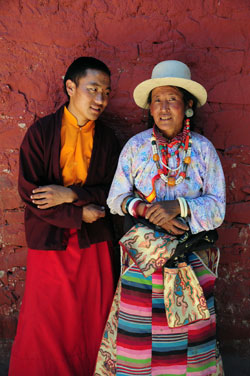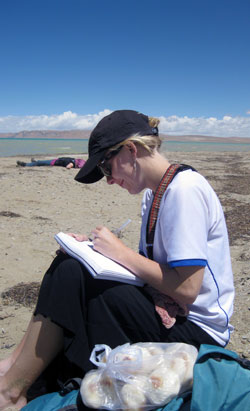
As part of it global outreach, the HSU Geography Department has offered the program since 2000. A presentation of student work will highlight the 2010 field trip and is scheduled for Wednesday, November 17, from 7 to 9 p.m. in Gist Hall 218.
Beginning in Beijing, participants documented many aspects of the great economic and social transformation that is sweeping China and which is now even reaching parts of its distant western hinterland.
Until recently, the region’s isolation offered a measure of protection for its physical and cultural landscape; rapid change is now increasing pressure on its rich natural resources and traditional cultural character.
Getting out there involved traveling in 4×4 vehicles for nearly 2,500 miles while crossing the Tibetan Plateau. At selected study sites students explored and documented the region’s distinctive geography, from sharing a pilgrim’s path through mountaintop cloud forests overlooking the Indian border to crossing the Chang Tang, Tibet’s vast northern plains. Dotted with deep blue lakes and distant snow capped mountains, the Chang Tang is home to some of the most threatened wildlife in Asia and has been labeled as one of the last practically unexplored places on earth by noted wildlife biologist George Schaller.

Throughout the journey, daily encounters with the region’s rich biodiversity and traditional culture brought a first hand appreciation for its unique character and a better understanding of the challenges it faces.
Community service projects have been an integral part of the program and this year’s plans to build greenhouses in eastern Tibet had to be postponed because the 6.9 Yushu Earthquake devastated our host community in eastern Tibet. Immediately after the disaster, the HSU Geographic Society launched an ongoing fund raising campaign that has collected more than $1,500. Donations will be used to directly aid survivors, many of whom are living in tents and must endure the extreme plateau winter.
Arnold King, a 2008 program participant and former Geographic Society officer had volunteered with a local NGO in Yushu and was caught in the earthquake. Lucky to have survived this tragedy that took the lives of nearly 3000 people, Arnold continues with recovery work and has organized an exhibit and sale of photographs of Tibet for the upcoming December Eureka Arts Alive Night. Drawn from the China/Tibet Program archive, including a selection of his own images, the exhibit shows at both Los Bagels and All Under Heaven in Eureka on Dec. 4. All proceeds go directly to quake survivors.